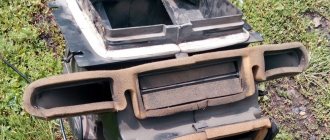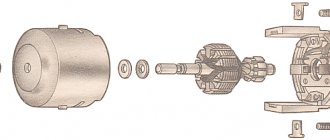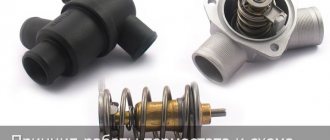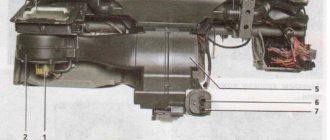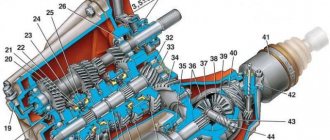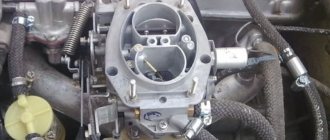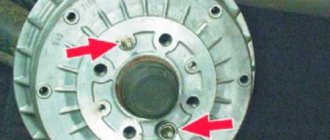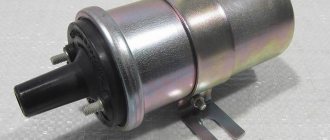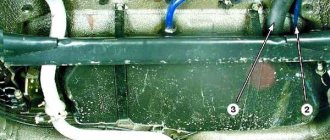Operating principle of the furnace system
As soon as the temperature outside the window drops below zero degrees, coolant in the car begins to flow directly through the furnace tap. After the engine warms up to the optimal temperature (about ninety degrees), antifreeze will begin to flow into the radiator.
Inside the car there is a special lever on the panel that is responsible for turning on the ventilation system. In the VAZ 21099 it is equipped with three power modes. You can also select the direction of the air flow. The air is directed using shock absorbers located at different points in the car.
Heaters old and new
Finally, we note that the VAZ-21099 of different years of production used heaters with certain design features that related to the angle of the radiator and the location of the main damper.
In so-called old-style stoves (on cars before 1998), the radiator was installed almost vertically, and the main damper was located under the heat exchanger. There was a partition between the rear wall of the case and the radiator, which formed a channel that provided air supply down the case.
When the damper was open, the air flow moved through the radiator, where it was heated and supplied to the air ducts. In ventilation mode, the main damper closed the heat exchanger, forming, together with the front wall of the housing, another channel through which the flow went directly to the air ducts.
In the new model stoves (on cars produced since 1998), the radiator position angle was significantly smaller than on old heaters, which is believed to provide a larger contact area of the air flow for heat exchange.
The position of the main damper and its shape also changed (it became arched). It began to be located above the radiator. In the closed position (ventilation mode), the damper ensures air movement along the shortest path to the air ducts. In heating mode, it blocked the cold air supply channel to the air ducts and directed the flow down the housing, from where it went to the heat exchanger.
Heating of the interior of any car is provided by air, which is heated in the heater radiator. The VAZ 2109 heater radiator is connected in parallel to the main radiator, which is part of the cooling system of a car engine.
The heater itself is secured with four nuts in the passenger compartment under the instrument panel to bolts that are welded to the air supply box. The air heated in the heater is directed through an air duct system into the passenger compartment. The air ducts are attached to the instrument panel from below and sealed with gaskets.
Stove design
Stove structure: 1 – elastic bushing; 2 – spring nut; 3 – left fan casing; 4 – electric motor; 5 – impeller; 6 – right fan casing; 7 – windshield heating flap; 8 – damper for the foot airflow channel; 9 – heater control damper; 10 – right heater casing; 11 – bracket for fastening the heater casings; 12 – gasket; 13 – radiator; 14 – clamp; 15 – supply hose; 16 – outlet hose; 17 – tap; 18 – left heater casing; 19 – sealing cover; 20 – resistor; 21 – support for the heater control damper axis.
Structurally, the VAZ 2109 stove consists of several parts:
- The outer casing is made of several complex configurations of plastic parts that fit tightly together and have seals.
- Air ducts are large-diameter corrugated tubes through which air is delivered to the nozzles in the cabin (at the windshield, on the driver and passenger sides). The amount of flow is regulated by valves.
- Control valves - they are located both inside the dashboard and on it. The former are adjusted through traction cables, and the latter directly manually.
- The radiator is made of aluminum and plastic. Tubes and plates are metal. Plastic - storage tank.
- Fan - runs on electricity and is powered from the on-board network (12 V)
- Rubber tubes - connect the expansion tank, radiator, pump. Coolant is supplied and discharged through them.
- The pump is also electric, pumps antifreeze and provides more intense heat exchange.
- Thermal sensor - installed inside the radiator and controls the operation of the pump and fan.
- The tap is controlled by a special lever and allows you to completely shut off the coolant flow in the system.
- Control levers and rod system - displayed on the dashboard and transmit influence to internal dampers and switches
- The vernier for turning on and adjusting the fan speed is also located on the front panel next to the levers.
- Electrical unit - power wiring and loading resistors.
Part of the system that provides interior heating includes an expansion tank with antifreeze. It is into this that the antifreeze that has released heat from the radiator enters.
Important! A VAZ 2109 may have a high or low panel, when the stove does not heat well, its repair is identical in both cases.
Design of the VAZ-21099 heater
And then everything is simple: the created flow passes through the radiator honeycombs, where heat exchange occurs, as a result, heat is transferred to the air, which then blows into the required zones through the air ducts.
The design of the VAZ-21099 stove includes several main components:
- stove body made of plastic;
- heating system radiator (connected to the cooling system);
- electric fan;
- air ducts;
- heater control mechanism.
This car used heaters of two modifications (old and new), which were slightly different in design, but their components were completely identical.
Housing, radiator, dampers
Thanks to the housing, the required redirection of heating is ensured, since the movement created by the fan motor is immediately fed into it, rather than being dissipated. The body of the VAZ 2109 stove itself consists of two halves, connected to each other with special brackets. To reduce flow losses, a seal is placed between its halves. Partitions are made inside both halves, which provide the correct direction.
There is also a niche inside this case into which the radiator is installed. Initially, the radiator was made of brass, but now it is almost always made of aluminum. The design of the stove radiator 2109 is identical to the main one (consists of two tanks, tubes through which coolant circulates, and plates that form honeycombs), but is significantly smaller in size.
Video: The stove in the VAZ 2108, 2109, 21099, 2110, 2111, 2112, 2113, 2114, 2115 HEATS poorly
Air is blown through the stove dampers, also installed inside the housing. These elements are movable, and thanks to them it is possible to close some and open other air ducts. There are three of them in total - the main one (heater control), an air duct that redirects between the foot area and the supply to the cabin, and a damper for supplying flow to the windshield.
Additional flaps are installed on the side and central deflectors. It turns out that by default, air from the housing constantly blows onto the deflectors and this is done so that the flow always has an exit. Thanks to the existing dampers, it is possible to provide simultaneous supply of hot air to several zones at once (the interior and the windshield or the windshield and the footwell area).
The main heater damper provides air flow to the radiator or bypasses it. This is all done because the heater also plays the role of a forced ventilation system for the interior. This allows for a supply of cool air in the summer. And to do this, you just need to redirect the movement bypassing the heat exchanger, and the supply of heated coolant to the radiator itself will stop. To disconnect the heat exchanger from the cooling system, a heater tap is used, which is located on the supply pipe in front of the radiator.
Fan
The air flow is created by a squirrel wheel fan driven by an electric motor. These two elements are enclosed in their own separate housing, installed on top of the heater housing. Moreover, it is structurally designed to provide the easiest possible access to the electric motor, since it is considered one of the weakest components of the system.
The design provides three modes of fan operation. This allows you to select optimal air supply conditions (cold or hot).
Control mechanism
Video: Useful tips for cars. Why does the VAZ stove not work?
To control the stove and redirect air movement and open and close the coolant supply valve, a control mechanism located on the center console is used. It consists of a three slider mechanism and a fan operating mode switch.
Features of the heater on the VAZ-2109
The stove on a VAZ is an ordinary heat exchanger. The heating system is connected to the engine cooling system through a heater valve. When the stove starts, this unit opens and antifreeze enters the radiator of the heating system.
Coolant temperature under normal conditions ranges from 70 to 90 degrees.
As the antifreeze circulates through the radiator pipes, it cools, which leads to the release of heat.
An important component of the heating system on the “nine” is the fan, which operates in one of three modes. This element directs the heated air mass into the nozzles, and the driver regulates the flow distribution using deflectors. In exactly the same way, air enters the car windows.
Main stove malfunctions
As we have already mentioned, the stove is connected to the internal combustion engine cooling system. Accordingly, heating problems may arise for the following reasons:
- Insufficient amount of coolant in the system.
- Clogging of radiator tubes.
- There are air pockets in the system. To eliminate them, you will need to unscrew the cap of the radiator or expansion tank and let the engine idle for a while.
There are a number of cooling system malfunctions that can also affect the performance of the VAZ-2109 heating system. We look at the most common ones.
The weak point of the heating system is the valve through which antifreeze enters the heater radiator. This unit may leak. In this case, it must be replaced with a new one.
Poor quality coolant causes damage to rubber pipes due to its aggressive chemical composition.
Check the condition of the pump, which is responsible for pumping antifreeze and circulating it in the cooling system.
Poor operation of the stove can be caused by incorrect operation of the electric motor that drives the heating system fan.
If you notice extraneous sounds in the operation of this motor, this is a signal for a number of problems:
- Possible overheating due to fuse failure.
- When operating at low speeds, warm air does not flow - the electric motor has failed or there has been a break in the electrical circuit of the heating system.
Possible breakdowns of the heating system
The main reasons why the VAZ 2109 stove does not heat well are interruptions or breakdowns of three components of the heating system:
| Radiator | Fan | Air ducts |
- Damage to the air duct assembly. The air ducts consist of plastic casings and large-diameter corrugated tubes. The flow of air through them is regulated by dampers. Seals protect against leakage of warm air or penetration of cold air. Problems in the operation of this unit most often arise when it becomes clogged with foreign particles of debris and dust. In this case, after inspection, the air ducts simply need to be cleaned of dirt. Another vulnerable part is the duct seals and dampers. The former can dry out and wear out - this leads to loss of tightness and leaks of warm air. The dampers often do not close completely. As a result, cold air penetrates the system and heating also does not occur.
- Fan assembly failure. The rotary-type blower fan on the VAZ 2109 is powered by electricity from the on-board electrical network through a ballast resistor. The switching itself and the rotation speed are regulated by the vernier on the control panel - it is located on the left side of the valve levers. Most often, the fan itself or the resistor burns out. If this is detected, they need to be replaced.
Advice! In a home garage, failure of these electrical parts can be detected by testing them with a multimeter.
- Radiator unit failure. This unit includes, first of all, the radiator itself, a temperature sensor (located between its plates), pipelines, and a motor pump (pumps antifreeze into the radiator and discharges it into the expansion tank).
- Failures related to this unit, and leading to the fact that the stove does not heat well on the VAZ 2109, come down to two groups:
- clogging of the internal volumes of pipelines with antifreeze deposits and other pollutants
- mechanical wear of rubber tubes, the radiator itself and the pump motor.
- Their determination is possible after disassembling the system and inspecting its individual parts:
- Are there any problems with fluid flow?
- are there any cracks or chips?
- Is the pump pumping liquid?
Why did the stove stop working on the VAZ 2109, 21099, 2114?
In harsh Russian winters, the stove saves the driver. But often in the most severe frosts it fails. What happened? Why doesn’t the stove work on the VAZ 2109, 21099, 2114? What to do? The age-old question.
Most likely, the stove failed due to a breakdown in the thermostat, which is why the antifreeze is not circulated along the usual route, large and small circles, but only in a large circle. To get the stove working properly, you will have to replace the thermostat, because repairing this part is very problematic and expensive.
The second, most common cause of failure is an air lock. This happens because, after active driving, while the engine is cooling, air accumulates in the radiator, which, under the influence of heat and steam, turns into a thermostat. And, if you start the engine a few hours after such transformations, this accumulated air is pumped into the radiator and, as a consequence of all this, an air lock occurs. You can solve the problem in the following way: you need to remove the pipe and slowly add antifreeze to the stove to the maximum level.
Another cause of stove failure may be the faucet. It is easy to determine the malfunction: if the faucet cannot be unscrewed to the limit, then the whole essence of the problem lies precisely in it. The problem is solved this way: we lift the crane cable, tightening it with pliers. If even pliers and your efforts are not able to move the faucet from its place, it means that oxidation has occurred in it. Then there is no point in repairing the part and you will have to replace it with a new one.
If the radiator is clogged, this can also lead to a breakdown. To diagnose, you just need to pull out the radiator and clean it thoroughly, using a vacuum cleaner. If after such a general cleaning the stove still does not work, then we are looking for the reason further.
Checking the functionality of the heater elements
The first step is to test the fan. To do this, you need to turn on the ignition, and then start the fan by setting its switch to the first speed position. If it is working properly, the sound of its operation should be clearly heard. If the cabin is quiet, open the hood and listen to the sounds of the fan in the engine compartment. If the heater fan is “silent,” it means that you will have to remove it from the car and have it checked by an auto electrician, or, if you have the appropriate knowledge, check it yourself.
If during the inspection no faults were found with the fan, it is installed in place, and air still does not blow from the stove, the cause of the problem should be looked for in the wiring. It is necessary to determine why there is no voltage supplied to the terminals of the fan motor and to fix the problem. When the VAZ-21099 stove does not heat, even if the fan is working, the reason for this should be looked for in other elements of the heater.
The next step in troubleshooting is to check how well the heater air ducts are working. It is necessary to open them all, and, one by one, raise your hand to check the air flow on the windows, into the feet of the driver and passenger, and into the car interior. The air flow should be felt well. If all the heater air ducts are open and there is no airflow from them, you will need to disassemble the stove itself and look for the causes of the problems there.
How to diagnose a problem with the heater motor (heater fan)
The design of the heating system on the “ten” is fundamentally different from what was on the old VAZ models. The most important feature and difference of the interior heater is that the VAZ 2110 heater radiator and its fan are located not in the cabin, but in the engine compartment. This design has its advantages, for example, to replace the heater radiator or stove fan, you do not need to completely disassemble the front panel (dashboard).
Another important difference is the electronic control of climate processes in the cabin. For this purpose, the VAZ 2110 is equipped with a so-called automatic heater control system (AHC).
The SAUO unit on the VAZ 210 of different years of manufacture is different. Since 1996, 4 types of SAUO controller have been produced. It is worth taking this into account when purchasing a unit as a spare part. It is this device that controls the temperature in the cabin and the operation of the fan. You can set the temperature from 16 to 28 degrees.
Dear customers, in order to avoid errors when sending an automatic heater control system (AHCS), indicate your car model and year of manufacture in the “Comment” line.
The heater fan does not turn on - it’s very simple to understand: with the car running, turn on the heater at speed. If no additional “noise” appears, then the fan does not turn on. Let us immediately note:
— for VAZ 2108 – 21099; 2113-2115 and their modifications, if the fan does not turn on at speed 1-2, but does turn on at speed 3, then the problem is in the additional resistor or in the heater operating intensity switch.
- for VAZ 2110-2112 and their modifications and their modifications produced before 2003, if the fan operates only in one position 2, an additional resistor on the heater body has burned out, which allows you to regulate the speed - the fan is connected through it in position “A” and 1 .
The main reasons why the heater fan does not work
1. The fuse has blown. The simplest and at the same time the most unpleasant malfunction, because replacing the fuse (active link going to the fuses basket) is very simple, and at the same time, we do not know the reason why it blew.
If the fuse blows, it means there is a short circuit somewhere (short circuit). In this case, you need to go through the entire fuse circuit and look for the source of the short circuit.
A fuse F7 with a current of 30A is attached to the stove. This fuse is also responsible for the cigarette lighter, headlight washer motor, glove compartment light, and heated rear window. So, if a fuse blows, then in addition to the heater fan, the above-mentioned electrical elements of the car will stop working.
2. Poor contact in the mounting block. Poor or oxidized contact in the mounting block is also a common disease. In this case, you need to move the block of flagella going to the mounting block.
3. The ignition relay is stuck. If your heater turns on only when warm, then the problem is in the ignition relay. It’s surprising, of course, how the ignition relay affects the operation of the stove, but the fact remains a fact. The relay needs to be replaced. By the way, it is located under the instrument panel in the center console.
4. For VAZ 2108 – 21099; 2113-2115 and their modifications
4.1. The stove turns on only in position 3 of the switch. If you encounter such a situation, then you need to replace the additional resistor. The fact is that in positions 1 and 2 of the heater switch, current flows to the fan through an additional resistor, and in position 3 - directly to the fan. Therefore, the conclusion follows that the additional resistor is faulty.
4.2. The stove (heater) switch does not work. To test the position switch, you will need a regular 12 volt marker light with two wires soldered on. Remove the center console of the instrument panel in order to gain access to the heater switch: turn on the ignition; close the negative wire of the light bulb to body ground, and connect the other to outputs 1-2-3 to an additional resistor (gray, white and red wire - usually). If the light is on, then the switch is working; if it is not on, then connect the lamp to the positive wire of the position switch. If the lamp does not light, then there is a break in the circuit somewhere or the fuse has blown out.
5. For VAZ 2110 – 2112 and their modifications produced before 2003.
5.1. the stove turns on only in one position 2, an additional resistor on the heater body has burned out, which allows you to regulate the speed - a fan is connected through it in positions “A” and “1”. In this case, you need to get to the heater (this is only possible from the engine compartment) and replace the resistor.
5.2. The interior temperature sensor is faulty. The heater operation algorithm should be as follows: at maximum (red dot) - movement to open the damper; at minimum (blue dot) - movement to close the damper, other positions are fixed depending on the temperature set by the interior temperature sensor. To see if the damper is moving, it is better to remove the front deflectors; they have two plastic latches on the right and left (be careful not to tear off the backlight wire when removing). After removing the deflectors, you can clearly see whether the damper is moving or not, i.e. air flows through the heater or not. Also check the resistance of the interior temperature sensor.
5.3. about burnt wires inside the controller (to eliminate it, you need to disassemble the controller and replace them). Pull the controller out of the socket. Turn on the ignition, turn the temperature knob and measure the voltage on the pink and brown wires (the long connector of the controller). If the voltage changes (should turn on after changing the position of the temperature knob and turn off after about 13 seconds), then the controller is working, if not, then the controller needs to be changed.
You can purchase an automatic heater control system (AHCS) from us!
DON'T STROKE - BUY CHEAPER! ! !
6 . The heater (heater fan) motor does not work. If the heater switch works, there is voltage, but the fan does not turn on, then either it is burnt out, or there is poor contact of the fan ground (the ground is located under the heater mounting nut), or the motor brushes are stuck.
DON'T STROKE - BUY CHEAPER! ! !
The information will also be useful to you: How to independently replace the heater fan on a car of the VAZ 2108-2112 family; 2113 - 2115, VAZ -2120 and their modifications produced before 2003?
If you haven't found the answer you are looking for, then ask your question! We will respond shortly.
Don’t forget to share the information you find with your friends and acquaintances, as they may also need it - just click one of the social networking buttons.
Repair and scheduled maintenance of the stove for VAZ 2109
Speaking about repairing the stove on a VAZ 2109, it should be noted first of all that most of the problems with this unit can be avoided by carrying out scheduled maintenance. It is its absence that causes sudden breakdowns at the most inconvenient moment (cold season).
The most important points are as follows:
- Regularly inspect air ducts and dampers - remove accumulated debris, clean the cabin filter, check the functionality of the dampers.
- If the seals on the dampers are worn out, they need to be replaced as soon as possible.
- When the dampers do not close tightly, you need to tighten the control traction cables.
- Antifreeze needs to be replaced regularly. The specific period depends on the brand and here you need to follow the manufacturers’ instructions.
- The tubes and the radiator itself need to be cleaned only with special branded liquids. Any amateur activity, for example using a sewer cleaner, will lead to failure of both the rubber tubes and the metal radiator (it will simply dissolve).
- The easiest way to remove a leaking faucet or not allowing antifreeze to pass through at all is to remove it from the system or replace it with a more wear-resistant tap. But in this case, it will become impossible to control it from the cabin through the rod and lever.
- The antifreeze level in the expansion tank must always be maintained at the proper level and when it drops, add what is missing.
Important! You only need to add additional antifreeze of the same brand that is used in the system. If you pour in another antifreeze, the system may become clogged with the resulting sediment.
Diagnosis of the reasons why the stove heats poorly on a VAZ 2109 should be carried out at medium engine speeds. The air temperature from the stove nozzles should reach 80-90 degrees Celsius in 5-10 minutes. Warming up the interior to +5 degrees from -10 degrees occurs in 10 minutes of operation of the stove.
Advice! If the stove does not heat well on a VAZ 2109 and it breaks down on the road, and there is no way to repair it, then the windshield will inevitably fog up. This can only be avoided by opening the side windows - this way, cold air from outside will prevent condensation from occurring.
Why does the stove blow cold air?
If the heater radiator on a VAZ-21099 has stopped heating, most likely the coolant circulation in it has been disrupted. This problem is also caused by a number of reasons, let’s look at them:
- It is quite possible that the coolant is outdated and, as a result, has lost its properties. Note that its service life is approximately five years. If during this time the antifreeze or antifreeze has never been changed, their structure begins to deteriorate with the formation of sediment, which, settling on the cooling lines, interferes with the normal operation of the system. This sediment also clogs the radiator, pipes and pipes of the heater, causing it to stop functioning normally and giving off heat. Therefore, it is necessary to free the system from the old cooling fluid by completely draining it, and then flush it using a special flushing compound. This liquid is poured into the cooling system, after which the power unit starts. The manufacturer indicates on the packaging how long it takes to use the flushing compound in the system with the engine running before draining it. After the flushing has been drained (it usually comes out of the system quite dirty), new coolant should be added in accordance with the manufacturer's instructions and the heater's performance checked. If after this the stove still does not heat, then its radiator is clogged. If, after cleaning and washing it, performance is still not restored, you will have to buy a new radiator.
- One of the most vulnerable elements of the cooling system is the heater valve, which is controlled from inside the car using a special lever on the heater panel. The lever and faucet have a traction connection. It is necessary to check the functionality of the faucet. This is done like this: we move the lever, while controlling the opening and closing of the tap. If the faucet remains motionless or does not open/close completely, then the draft needs to be adjusted.
- The VAZ-21099 stove heats poorly or does not work at all due to a drop in the antifreeze level in the cooling system. Because of this, air accumulates inside the heater radiator, and it practically does not function (it gives off little heat). To eliminate this, you only need to replenish the level of “cooling” in the system and constantly monitor it.
- Airiness in the cooling system of the power unit is also a common cause. The carburetor has a heating pipe, which must be disconnected, since it is the highest point of the system, and accordingly, an air lock forms there. The next step is to free the system from air; to do this, remove the cap of the expansion tank and blow it out. Air will begin to escape from the hose that was previously removed from the carburetor, but as soon as coolant flows in instead, the hose must be put back in place. Air in the system has been eliminated.
- The cause of the malfunction of the VAZ-21099 heater may be a failed thermostat, because of which the power unit does not reach the required temperature (90 degrees).
- Failure of the pump deprives the cooling system of fluid circulation. At the same time, the engine boils and cold air blows from the air ducts. In this case, it is recommended to replace the pump.
- https://remam.ru/vozdsys/pochemu-ploho-greet-pechka-na-vaz-21099.html
- https://litezona.ru/ploho-greet-pechka-vaz-21099-vysokaja-panel/
- https://AlanSpb.ru/drugoe/pechka-2108.html
- https://provaz2109.ru/pechka-i-otoplenie/pochemu-ploho-greet-pechka-na-vaz-2109.html
- https://europe-car-gid.ru/ploxo-greet-pechka-na-vaz-21099/
The cold weather has arrived, and most owners of the VAZ 2109 are once again faced with a problem: from the nozzles of the heater pipes at the operating temperature of the coolant (about 90 degrees), barely warm, and often completely cold air is blowing into the cabin; in short, the heater does not heat well. In this state of affairs, in severe frost, even frosty side windows in the cabin “do not come off.”
The simplest solution to this problem is as follows. It is necessary to tighten the heater damper control cable. To do this, you can make one or two turns of this cable on the damper control lever. This lever is located on the body of the VAZ 2109 stove, next to the gas pedal (see photo).
Location of the VAZ 2109 heater damper lever
All the joints of the air ducts and the edges of the stove damper are covered with foam rubber, which is difficult to fully compress using the damper control lever. This leaves a gap of several millimeters. In this case, the damper directing the flow of air either from the street directly or through the heater radiator does not close completely. It closes “up”, while air flows into the front nozzles through the heater radiator, and into the top and side nozzles from the street, through those same millimeters. When the heater fan is running, and the car is moving, these millimeters are quite enough.
You can even get to this damper lever on the driver's side and try to tighten this lever with your hand while the heater fan is on. In this case, the left ear will be in the area of the air duct nozzle, and you can hear how the sound and temperature of the air leaving the nozzle changes.
Also, the reasons discussed below may be the reason for the ineffective operation of the Samara interior heating system.
Incomplete opening of the heater tap
This problem occurs in most front-wheel drive VAZ cars. You can check this by comparing the temperature of the inlet and outlet pipes of the heater radiator; if it is different, most likely the valve is not fully open. The solution is to tighten the control cable for this valve and adjust the valve control lever to the maximum open position. In this case, it is possible that now the valve will not close completely, but as they say, the heat does not break the bones. But here lies another problem. It is known that this valve in Samar is a weak point, and after a certain number of “open-close” operations, the valve at the location of the axis connecting the control lever and the valve itself inside the valve loses its tightness and begins to leak. Some owners simply set the “heat-cold” lever to a certain position and leave it out of harm’s way. In this case, attempting to move the heater tap valve will most likely cause it to leak. If this happens, you can wrap a strip of fabric soaked in sealant around the leak site and fix it all with “cold welding”; this can also be done in the field if the necessary materials are available.
Location of the Lada Samara stove valve leak
A radical solution to the problem with a leaking heater tap on the VAZ 2109 would be to completely remove it from the system, or install a water supply ball valve. True, in the first case, the ability to adjust the volume of coolant entering the heater radiator is lost, and in the second case, this adjustment can only be made by looking under the hood. But, having got rid of a obviously unreliable unit, we get rid of possible problems in the future, and the remaining adjustment of the temperature of the air entering the cabin by the damper is enough for the eyes. By the way, in the “tens” the manufacturer removed this ill-fated valve.
Air duct leaks
The air forced by the stove fan partially goes into the cracks in the air paths, while the air flow weakens and cools. The solution would be to seal and seal all connections along the air path from the stove to the outlet nozzles. True, this operation is very labor-intensive, since you will have to disassemble the entire front panel, but the result will be a noticeable increase in air flow from the heating system deflectors.
Air locks in the heater core
This problem is indicated by cold air from the cooling system deflectors when the heater valve is open at the operating temperature of the coolant. In this case, you need to place the car with the front wheels on a hill, as high as possible, open the heater valve fully and turn on the gas.
Also, to warm up the interior, I recommend installing a 6-hole thermostat from a VAZ 2110 according to a modernized design.
Car owners of “nines” know the operating features of their car’s heating system. When everything is fine in summer, in winter the opposite situation occurs, and cold air enters the cabin. And this is already unpleasant, and also harmful to health. In addition, the side and windshields fog up. Problems with the VAZ-2109 stove must be resolved in advance in order to be fully equipped for winter.
The stable operation of the heating system in a car can be influenced by a huge number of factors. Therefore, before you begin troubleshooting, you need to generally understand how the system works.
Sources
[collapse]
Basic malfunctions and methods for their elimination
There can be many reasons for the malfunction, here are the most common ones.
Warm air does not flow well into the cabin or does not flow at all
Malfunction of the fan or switch handle - one of the common reasons is a breakdown of the electric motor of the fan, wiring, or switch handle.
Test methods - to check this fault it is necessary; turn on the vehicle ignition, turn the control lever to the first position, listen.
The sound of the fan should be audible in the cabin, if not, then you need to open the hood and listen there. If the sound of the fan is not heard, the reason is in it or the switch.
Troubleshooting - remove the fan motor, check it, if it is fixed, check the serviceability of the wiring and the switch handle and fix the problem.
Malfunction of the air ducts - if the fan is working, but the air does not enter the cabin.
Fan motor failure
It may also happen that the fan motor itself “flies”. To make sure that this is why the furnace fan is not running, turn on the furnace system. Listen carefully to the presence/absence of characteristic sounds. If the fan is running, you will hear a specific buzzing sound. If the motor burns out, it will need to be replaced.
If the fan motor is running, there is a possibility that the fuse has blown, resulting in electrical equipment failure and contact failure. This is not difficult to determine. With good connections, the instrument panel shines clearly, the headlights distribute light evenly, and the wipers move actively.
Prevention and care of the VAZ-2109 stove
To avoid problems with the stove in cold weather, it is recommended to periodically maintain the system. Use the following recommendations:
- Clean the radiator from internal contaminants that may accumulate during long-term use.
- Use only high quality coolant. You should not save on such consumables. Low quality products can clog the system or damage the rubber pipes. Accordingly, it is better to use a good antifreeze than to subsequently incur additional expenses on repairing the cooling or heating system.
- Check the thermostat's operation regularly. This device is designed to maintain a certain temperature in the system. If the unit jams, the liquid will not flow into the stove radiator, and the motor will begin to overheat.
- Pay attention to the condition of the fan bearing. From time to time it is recommended to lubricate this element.
